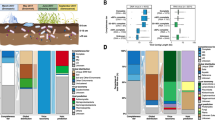Efforts to understand and improve soil bioremediation are limited by our ability to determine how treatment variables affect microbial communities. A method was developed to monitor the density and metabolic activity of the total bacterial community in soil. This method was used to monitor the bacterial community in microcosms of Arctic soil after addition of N plus P to stimulate biodegradation of hydrocarbon contaminants. During 29 days of incubation, the total petroleum hydrocarbon level in the soil was reduced from 850 to 360 mg/g of soil. DNA and RNA were extracted from soil using a bead beating method, purified by ammonium acetate precipitation, and assayed by competitive PCR and RT-PCR assays with universal bacterial primers. The copy number of 16S rDNA in the soil microbial community was relatively stable and ranged from 1.7 × 109 to 4.5 × 109/g of soil throughout the incubation. The copy number of 16S rRNA changed substantially and ranged from 5.6 × 1010 to 1.0 × 1012/g of soil. The rRNA:rDNA ratio was highest during the phase of fastest hydrocarbon biodegradation. These results suggest that the treatment to stimulate hydrocarbon biodegradation did not substantially change the density of the bacterial community but did transiently increase its overall metabolic activity.
Similar content being viewed by others
Author information
Authors and Affiliations
Rights and permissions
About this article
Cite this article
Ka, J., Yu, Z. & Mohn, W. Monitoring the Size and Metabolic Activity of the Bacterial Community during Biostimulation of Fuel-Contaminated Soil using Competitive PCR and RT-PCR. Microb Ecol 42, 267–273 (2001). https://doi.org/10.1007/s00248-001-0003-2
Received:
Accepted:
Issue Date:
DOI: https://doi.org/10.1007/s00248-001-0003-2




